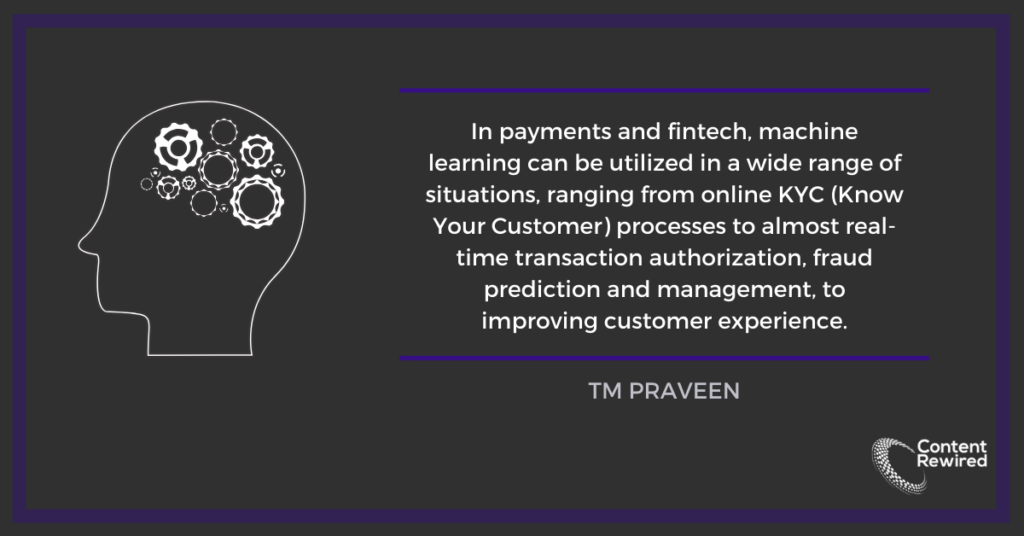Last Updated on August 3, 2023 by admin

In part eight of our payments Q&A, we discuss digital payment solutions, consumer-centric payments, and the future of machine learning. We spoke with TM Praveen, CEO of Opus Consulting, a technology company focused on solving complex business problems for the Payments industry.
Ashley Poynter: By next year, 40% of US consumers will be made up of Gen Z, who are spending an estimated $143 billion a year. How will this impact digital payments trends as well as how financial institutions respond to changing consumer demands?
TM Praveen: Gen Z is already a critical factor for all consumer-led innovation. It’s the generation that prefers instant and seamless commerce. Modern payment channels such as Google Pay, Amazon Pay will continue to rule the roost as they know this generation’s needs the best. Digital payment solutions will continue to be on the rise and the buying behaviour of Gen Z will influence other consumers.
AP: Mobile payments have been gaining momentum with over one-fifth of the US population using them last year. That said, the US is slower than other countries in adoption. Why? And will this continue to be the trend in 2020?
TMP: That’s right. Though Americans have been early and rapid adopters of smartphones, it is quite ironic that mobile payments aren’t as popular as they should have been here. Though technology has very little to do with this, a few reasons that come to my mind for this are a pretty legacy financial ecosystem, lack of a central governing financial body and the prevalence of a consumer-centric, card-based rewards system.
AP: 2019 ushered in quite a bit of consolidation in the payment’s ecosystem (Fiserv buying First Data, FIS acquiring Worldpay, etc.). What do you think this signals in terms of the new landscape of the industry?
TMP: Consolidation of leading payments organizations is certainly paving way for a new era of customer acquisition. This is driven by a strategic rationale and the rapid digitisation of payments has pushed large payment companies into building a bigger appetite for online transactions to grow their revenue.

AP: Machine learning is becoming widely used across industries, but especially in the payments sphere. Where do you see this trend headed and what are the unique advantages to machine learning’s application in payments and fintech?
TMP: In payments and fintech, machine learning can be utilized in a wide range of situations, ranging from online KYC (Know Your Customer) processes to almost real-time transaction authorization, fraud prediction and management, to improving customer experience. The number of use cases is proportional to the staggering growth in the number of payment transactions and it is exciting to see the reformation machine learning will drive.
If you missed our other Q&A articles, you can view them here:
- Payments Q&A: IBM’s Dave Maddox on Consolidation, Emerging Payment Platforms, and Blockchain
- Payments & Fintech Q&A: Scarlett Sieber on Apple Card, Gen Z, and Cryptocurrency
- Quick Hit Payments Q&A with Holly Hughes
- Payments Expert Q&A: Gregory Leos Talks Acquisitions, Digital Payments, and Mobile Skepticism
- Payments Leaders Q&A: Fiserv’s Stephanie Foster Discusses 2020 Predictions, Connected Experiences, and Open Banking
- Payments & Cybersecurity Q&A: Dominic Vogel Talks Data Breaches, PCI Compliance, and Top Payments Threats
- Real-Time Payments Q&A: David Jackson Talks Faster Payments Task Force and Real-Time Payments
Stay tuned in the coming weeks. I will be interviewing more experts on the evolution of the payments world, shifts in the ecosystem, and what to expect in 2020.
If you’re interested in participating in one of our Q&A With the Experts series, please send us a note here.



